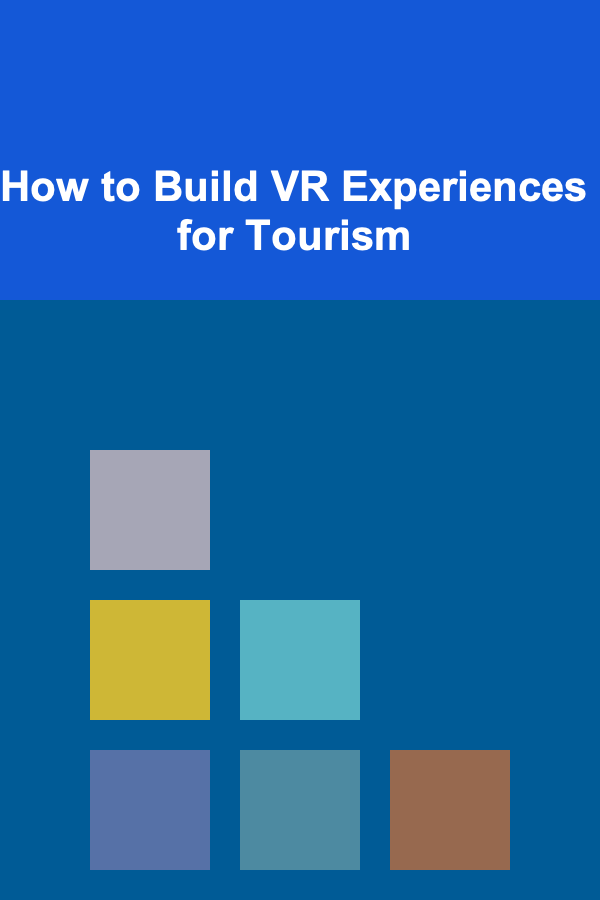
How to Build VR Experiences for Tourism
ebook include PDF & Audio bundle (Micro Guide)
$12.99$5.99
Limited Time Offer! Order within the next:

In the rapidly evolving landscape of technology, Virtual Reality (VR) has emerged as one of the most impactful tools for various industries, and tourism is no exception. As the global tourism industry grapples with challenges like overcrowding, sustainability, and an increasing demand for personalized experiences, VR offers a novel solution to these problems. By enabling tourists to "visit" destinations without leaving their homes or to experience immersive, personalized interactions, VR has the potential to revolutionize the way people explore the world.
Building effective VR experiences for tourism is more than just creating a virtual simulation of a place. It involves thoughtful design, understanding user needs, integrating the right technologies, and making sure the experience is engaging, informative, and ultimately satisfying. In this article, we'll explore how to build immersive VR experiences for tourism, from conceptualization to execution, and dive deep into best practices and technologies to help guide you through the process.
Understanding the Need for VR in Tourism
Virtual reality allows users to experience a destination without physically traveling there, making it an invaluable tool for the tourism industry. VR can be used in a variety of ways, including:
- Pre-Trip Exploration: Potential tourists can explore destinations before making a decision to visit, helping them make more informed choices about where to travel.
- Destination Promotion: Tourism boards, hotels, and attractions can use VR to showcase their offerings in an engaging way, encouraging potential visitors to take the plunge.
- Experiencing the Unreachable: For people who cannot travel due to physical, financial, or other constraints, VR can provide access to places they may never visit in real life.
- Immersive Cultural Experiences: VR can simulate cultural or historical experiences that would be impossible to experience in person, offering tourists a deeper connection to a destination.
Defining the Goals of the VR Experience
Before diving into the technical aspects of VR development, it's important to define the goals of the VR experience. The objectives will shape the entire process, from the technology you choose to the content you create. Some common goals for VR tourism experiences include:
- Enhancing Marketing and Branding: VR can be a powerful tool for destination marketing. By showcasing beautiful landscapes, rich cultural heritage, and exciting activities in an interactive format, you can attract tourists who might otherwise not have considered the location.
- Providing Educational Content: Historical sites, museums, and cultural tours can provide tourists with engaging, educational content through VR. Visitors can interact with virtual objects, listen to narrations, and watch documentaries to enhance their understanding of a destination.
- Creating Immersive Experiences: One of the main draws of VR is the ability to immerse users in environments in a way that traditional media cannot. For example, you could create a virtual scuba diving experience in the Great Barrier Reef or simulate a hike through the Swiss Alps.
Designing the VR Experience
The design phase is crucial to creating a VR experience that is not only immersive but also functional. Here are the key components to focus on:
3.1. Storytelling and Narrative
One of the most compelling aspects of tourism is the stories behind the destinations. Whether it's the history of a city, the legend of a famous landmark, or the story of the local people, storytelling is integral to building an emotional connection with a tourist. A VR experience should embrace this storytelling aspect and allow the user to interact with the narrative.
For instance, if you're designing a VR tour of ancient Rome, you could have users "walk" through the Roman Forum while hearing stories about its history, the people who lived there, and significant events that took place. This kind of narrative-driven experience adds depth to the user's understanding and makes the journey far more engaging.
3.2. Interactivity
While passive VR experiences---where users simply view the content---are common, the future of VR in tourism will be interactive. Interactivity allows tourists to feel like active participants rather than mere observers. This could include interacting with objects, navigating through different environments, or even participating in local activities, such as cooking a traditional dish or crafting an artisan object.
The level of interactivity will depend on the complexity of the VR platform and the goals of the experience. For example, users on a historical tour might engage with virtual objects, while on an adventure tour, they might be able to make decisions that affect the outcome of the experience, like choosing different routes on a hike.
3.3. Realism and Immersion
Realism is key to creating an immersive VR experience. The goal is to make the tourist feel like they are truly "there," experiencing the destination in all its glory. This means paying attention to the following aspects:
- Visual Quality: High-resolution images, realistic textures, and attention to detail are essential. In some cases, 360-degree photography or video can be used to capture real-life environments.
- Audio: Surround sound or spatial audio can add a layer of realism, such as the sounds of birds chirping in a park or the hustle and bustle of a market street. Audio narration or local language options can also enhance the experience.
- Movement and Navigation: Users should be able to move freely within the virtual environment. This could involve walking around a city or floating through space, depending on the nature of the experience. Movement should be smooth and intuitive, reducing the likelihood of VR motion sickness.
3.4. Accessibility and Usability
Creating an inclusive VR experience means making it accessible to a wide range of people, including those with disabilities. Consider the following aspects when designing:
- Subtitles and Translations: Provide text support for non-native speakers and hearing-impaired users.
- Customizable Controls: Allow users to adjust controls based on their physical abilities. For example, providing options to change the movement speed or to pause the experience at any time.
- Comfort Features: For those prone to VR motion sickness, offer options like teleportation-style navigation or comfort settings that limit visual movement to reduce discomfort.
Choosing the Right Technology
The technology you choose will play a significant role in determining the success of your VR experience. The choice of hardware, software, and platforms should align with your goals and target audience.
4.1. Hardware Choices
The two main types of VR hardware to consider are:
- PC-based VR Systems: These VR systems offer the highest level of immersion and quality. Popular examples include Oculus Rift and HTC Vive. They are capable of handling complex and detailed environments but require a high-end PC, which can make them expensive for both developers and users.
- Standalone VR Headsets: Devices like the Oculus Quest are self-contained and don't require a PC to operate. While they may not offer the same level of detail and graphical performance as PC-based systems, they are much more accessible and cost-effective for both developers and users.
The choice of hardware will depend on the level of realism you need. If you're developing a simple, 360-degree virtual tour, standalone headsets may suffice. However, for more complex, interactive experiences, you may need PC-based systems.
4.2. Software and Development Tools
Creating VR experiences requires specialized software tools. Popular VR development platforms include:
- Unity: One of the most widely used game engines, Unity allows developers to create rich, interactive VR experiences. It supports a wide range of devices and is relatively beginner-friendly.
- Unreal Engine: Known for its stunning visual capabilities, Unreal Engine is another powerful tool for building VR experiences, particularly those requiring high graphical fidelity.
- 360-Degree Video Software: For simpler VR tours, you may opt to use 360-degree video software like Pano2VR or Kolor. These tools allow you to stitch together 360-degree videos that users can explore interactively.
4.3. VR Platforms and Distribution
Once your VR experience is developed, you'll need to decide how to distribute it. The platform you choose will depend on your target audience:
- App Stores: If you're developing a mobile VR app, distributing through platforms like the Google Play Store or Apple's App Store is a straightforward option.
- VR Marketplaces: Platforms like Oculus Store and Steam VR are tailored for VR content and allow you to reach an audience specifically interested in immersive experiences.
- WebVR: For simpler, web-based VR experiences, you can use WebVR, a standard that allows VR content to be accessed through web browsers, making it more accessible to users who don't own dedicated VR hardware.
Testing and Iteration
Once your VR experience is built, it's time to test it rigorously. This phase is crucial for ensuring that the experience is both technically sound and enjoyable for users. Testing should focus on:
- Performance: Does the experience run smoothly? Are there any lag issues or glitches that could break immersion?
- Usability: Are the controls intuitive? Is the experience easy to navigate, even for first-time VR users?
- User Engagement: Does the experience hold the user's attention? Are there any aspects that feel too long, too short, or too repetitive?
User feedback is invaluable during this phase, and iteration is key to improving the experience. Make adjustments based on testing results and continue refining the VR experience to meet your objectives.
Marketing and Launch
Once your VR tourism experience is ready, it's time to launch and market it. Consider the following strategies:
- Collaborations with Tourism Boards: Partner with local tourism organizations to promote your VR experience and showcase their destinations.
- Social Media Campaigns: Share sneak peeks of the experience on platforms like Instagram and YouTube to generate interest before the launch.
- Content Marketing: Publish blogs, articles, or videos that highlight the benefits of using VR for tourism and offer insights into the destinations featured in your experience.
Conclusion
Building VR experiences for tourism is a complex yet rewarding endeavor. By combining cutting-edge technology with creative storytelling and interactive design, VR can transform how people explore the world. Whether you're looking to enhance tourism marketing, provide immersive cultural experiences, or offer pre-trip explorations, the potential of VR in tourism is vast. With the right planning, design, and execution, VR can be a powerful tool in shaping the future of travel.

10 Simple Ways for Saving Money on Streaming Services
Read More
How to Build a Checklist for Conducting Security Audits After Employee Departure
Read More
How to Install Under-Cabinet Lighting in the Kitchen
Read More
How to Reduce Debt While Building Wealth
Read More
How to Sell Vintage Comic Books on Online Marketplaces: A Comprehensive Actionable Guide
Read More
Top Tips for Saving Money on Baby Diapers and Wipes Without Compromising Quality
Read MoreOther Products

10 Simple Ways for Saving Money on Streaming Services
Read More
How to Build a Checklist for Conducting Security Audits After Employee Departure
Read More
How to Install Under-Cabinet Lighting in the Kitchen
Read More
How to Reduce Debt While Building Wealth
Read More
How to Sell Vintage Comic Books on Online Marketplaces: A Comprehensive Actionable Guide
Read More